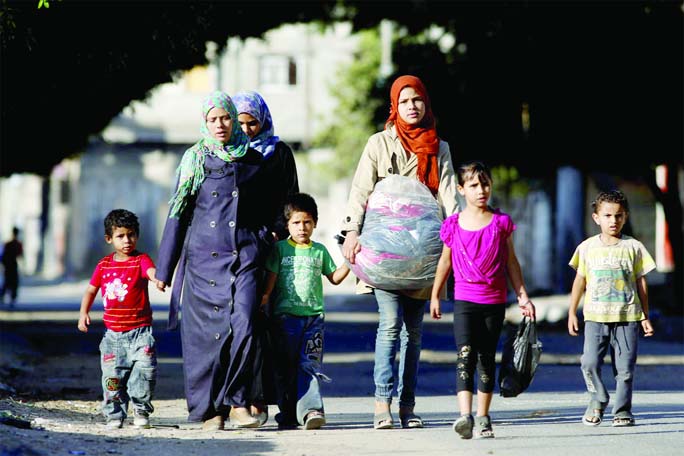
News desk :Civilians in Gaza are bearing the brunt of the Israeli offensive, which has killed 209 Palestinians in a little more than a week. Four children died Wednesday in Israeli airstrikes in Gaza, according to Gaza Health Ministry spokesman Ashraf al-Qidra.The one fatality on the Israeli side so far was a man killed Monday after being hit by a mortar shell at the Erez border crossing, Israeli Rescue Services said.Shuja’iya, a neighborhood east of the center of Gaza City, looked like a ghost town Wednesday after many people had fled during the night.Shops in the area’s central market had their shutters down and locked.”We are all scared, but we are force to live in this, and there is nothing for us to do,” said Abu Musbah, a, 21-year-old member of Islamic Jihad, one of the groups that is firing rockets at Israel. “The children are scared but we struggle to continue our lives.”He said he had already evacuated all of his family members from his house in Shuja’iya.One day after a cease-fire collapsed in Gaza, Palestinian Authority President Mahmoud Abaas traveled to Cairo on Wednesday for a meeting with the Egyptian President to discuss ways to end the conflict with Israel.Egypt, seeking to flex its regional muscle, had brokered the earlier deal as well, but Hamas leaders complained they had not been consulted and the scope of the cease-fire was too narrow.Abbas, whose more moderate Fatah party is in power in the West Bank, was to meet Wednesday with Egyptian President Abdel Fattah el-Sisi. Abbas is later scheduled to visit Turkey to discuss peace proposals.When the Egyptian plan was announced, there was a split reaction from Hamas. Its military wing rejected any possibility of a cease-fire, while its political wing had said it was considering it. Hamas spokesman Osama Hamdan later stressed that Hamas never received the proposal through political channels.”I believe a proposal is supposed to be prepared after the sides agree on it,” he told CNN. “It’s supposed to be published if two sides give agreement on it. You can’t publish it in the media and then ask everyone to accept that or reject that.”Asked why Hamas won’t stop firing rockets while talks are ongoing, the spokesman replied: “We are not the side who is killing the other side. We are the side being killed.”US State Department spokeswoman Jen Psaki said the United States is “hopeful that the political wing of Hamas can have some influence on the military wing.””We know there’s influence that many countries in the region can have here,” she told CNN’s “Erin Burnett OutFront,” suggesting the Egyptian proposal could be “a basis for a discussion.” US Secretary of State John Kerry strongly condemned Hamas’ rocket launches in the face of the cease-fire plan and said he is prepared to fly to the Middle East as early as Wednesday, if needed.Israel accepted the cease-fire and paused airstrikes for about six hours on Tuesday. “We held our fire for six hours and during that time, Hamas continued to barrage our cities with rockets,” Israeli Prime Minister Benjamin Netanyahu said Wednesday. “Hamas thus shut the door to a diplomatic solution, and it therefore bears sole the responsibility for the continuation of the violence.” Before agreeing to a cease-fire, Hamas leaders are likely to demand a broader range of conditions meant to address the concerns of Gaza residents, including the status of border crossing and Israeli operations in Gaza, said Yousef Munayyer, executive director of the Palestine Center, a pro-Palestinian think tank. “I think what they want is to see a cease-fire agreement that addresses the real problems that they face and the system of violence that is this siege, that is the occupation, so that it can be a genuine cease-fire agreement that brings an end to hostilities, not just from one side,” Munayyer said.World powers urged calm, worried about spiraling casualties should Israel send tens of thousands of troops it has mobilised into Gaza. It is one of the world’s mostly densely populated areas, its poverty exacerbated by the collapse of public works and displacement of at least 18,000 Palestinians who the UN said have taken shelter at its Gaza City schools.On Tuesday, Israel unilaterally accepted an Egyptian blueprint for a ceasefire. The dominant Palestinian Islamist group Hamas, however, said it had not been consulted by Cairo and kept up rocket attacks while Israel held back for six hours.With Palestinian fire having inflicted the first Israeli fatality of the conflict – a civilian bringing food to soldiers near Gaza – Netanyahu vowed to “expand and intensify” to stop persistent rocket strikes that have made a race for shelters a daily routine for hundreds of thousands in the Jewish state.”The direction now is to continue air strikes and, if need be, enter with ground forces in a tactical, measured manner,” an Israeli official said after the security cabinet met overnight.The Israelis blew up a cross-border tunnel last week which, they say, may have been just one of many that Hamas has dug for deadly infiltration raids on their southern towns.While tunnel-hunting incursions would be far short of a full-scale invasion and reoccupation, there is still the danger for Israel that risky and time-consuming missions could fall to Palestinian ambushes.Hamas leaders have talked up their “tunnel campaign” against the Israeli enemy. One publicity video showed Palestinian fighters hauling rockets through a narrow passage to load onto a launcher that appears buried in an orchard. It is then fired remotely after its mechanised cover slides open.

